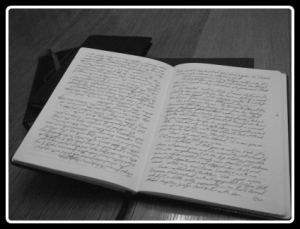 I’ve waxed romantic around here before about scribblebooks, but that’s always been late in the week when I was talking to my creative writers. Scribblebooks are great for the Art School types, but they don’t have a lot of appeal for serious business writers.
I’ve waxed romantic around here before about scribblebooks, but that’s always been late in the week when I was talking to my creative writers. Scribblebooks are great for the Art School types, but they don’t have a lot of appeal for serious business writers.
And actually…I complain sometimes about my day job, but I’ve always been a pretty technical sort, even when I’m caught up in my creative side. Technical Writing holds a real appeal to me whether or not I need it to pay the bills, and for precisely that reason it took me a little while to settle into using scribblebooks.
My first scribblebook was a gift to me in high school, and it came with the sincere dedication:
Aaron,
This book is for you to sketch down your thoughts and poems.
Love, Lindsay
It seemed far too small for the grand, world-changing ideas I was busy with in my writing, but I used it to capture notes to myself. The pagers were unlined, too, so it made a handy sketchbook, and I’d scratch out rough sketches of scenes from my book from time to time (usually while I was bored in some science or history class).
A couple years later I got to college and needed to take a lot more notes to keep up with everything I was doing. I dug out my old, almost-forgotten scribblebook and put it to use for class notes (and, once again, doodling when I was bored in Gen Eds).
That’s when I really started seeing the potential of it, too. I carried it with me everywhere, and it became my address book, my datebook, and it finally started to serve its initial purpose as I started capturing snippets of prose I wanted to put in a book someday.
On my mission trip, it became a security blanket, and I’d dive into its pages when I needed to escape all the people. I wrote poems about the cold loneliness of religion that made it into my college literary magazine, and notes to myself trying to capture the memories of these fascinating people I met for a moment, and wanted to remember for a lifetime. The last page has a tally of all the things I’d bought while in Britain, scribbled during the last half hour of my flight home so I could report it all to customs.
I got back from that trip absolutely dependent on my scribblebook, and devastated that it was full. Trish got me a new one right away, and after I filled that one, too, I ended up going back through both of them and filling up every half-inch of whitespace I could find with a rough outline for a non-fiction book on grilling that I never got around to writing.
Page Layout
I wouldn’t expect everyone to see the beauty I find in a well-abused scribblebook, but there’s a certain magic to the humble piece of paper. It’s amazing how many different purposes it can serve, how many forms of communication it offers — formal and informal, private and public.
This week I want to talk to you about pages — paper size, page orientation, and margins. It might seem like a trivially basic concern, but getting the foundation right will make the whole rest of your structure stronger. So come back tomorrow for a look at the various aspects of page layout in a professionally-formatted document.





